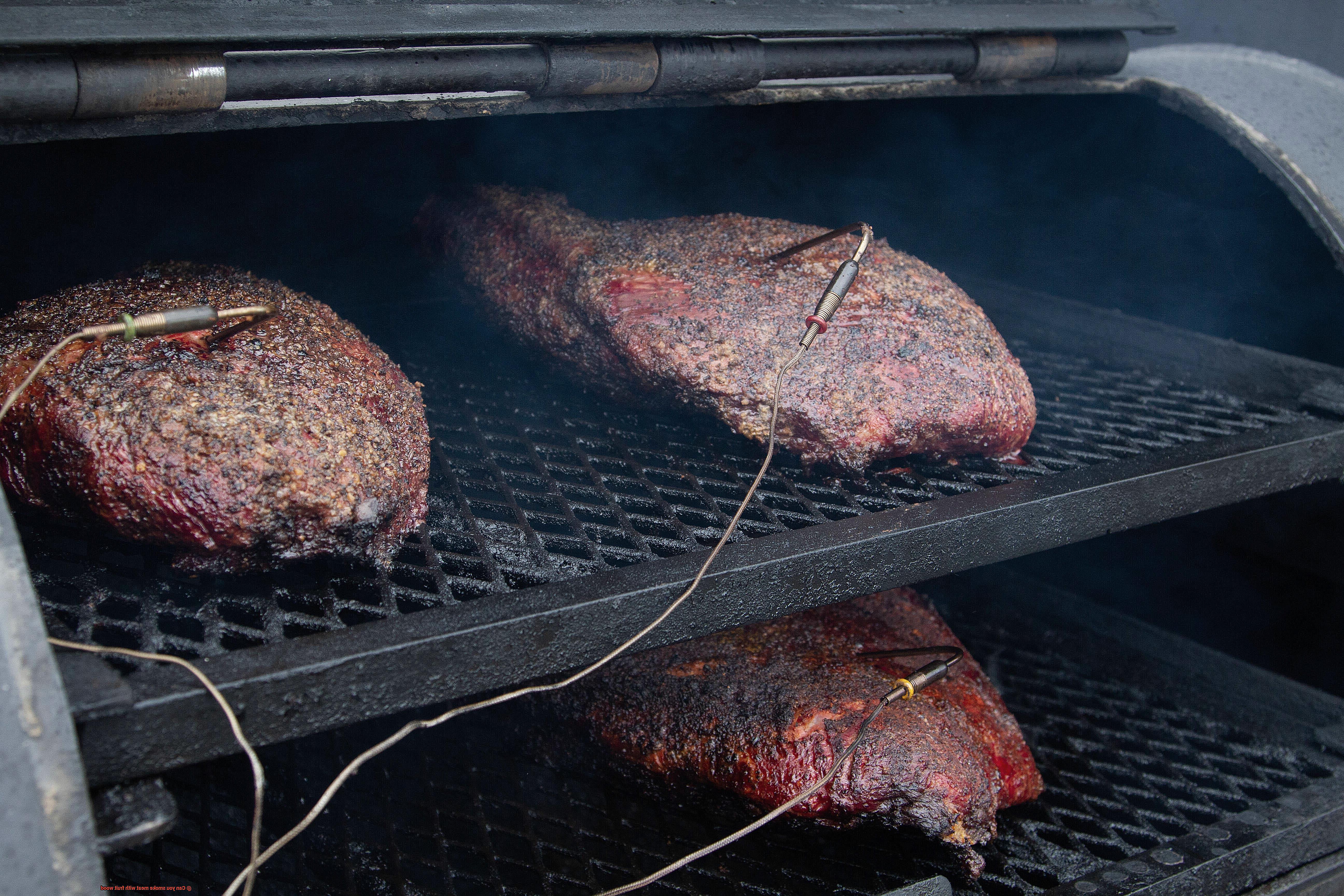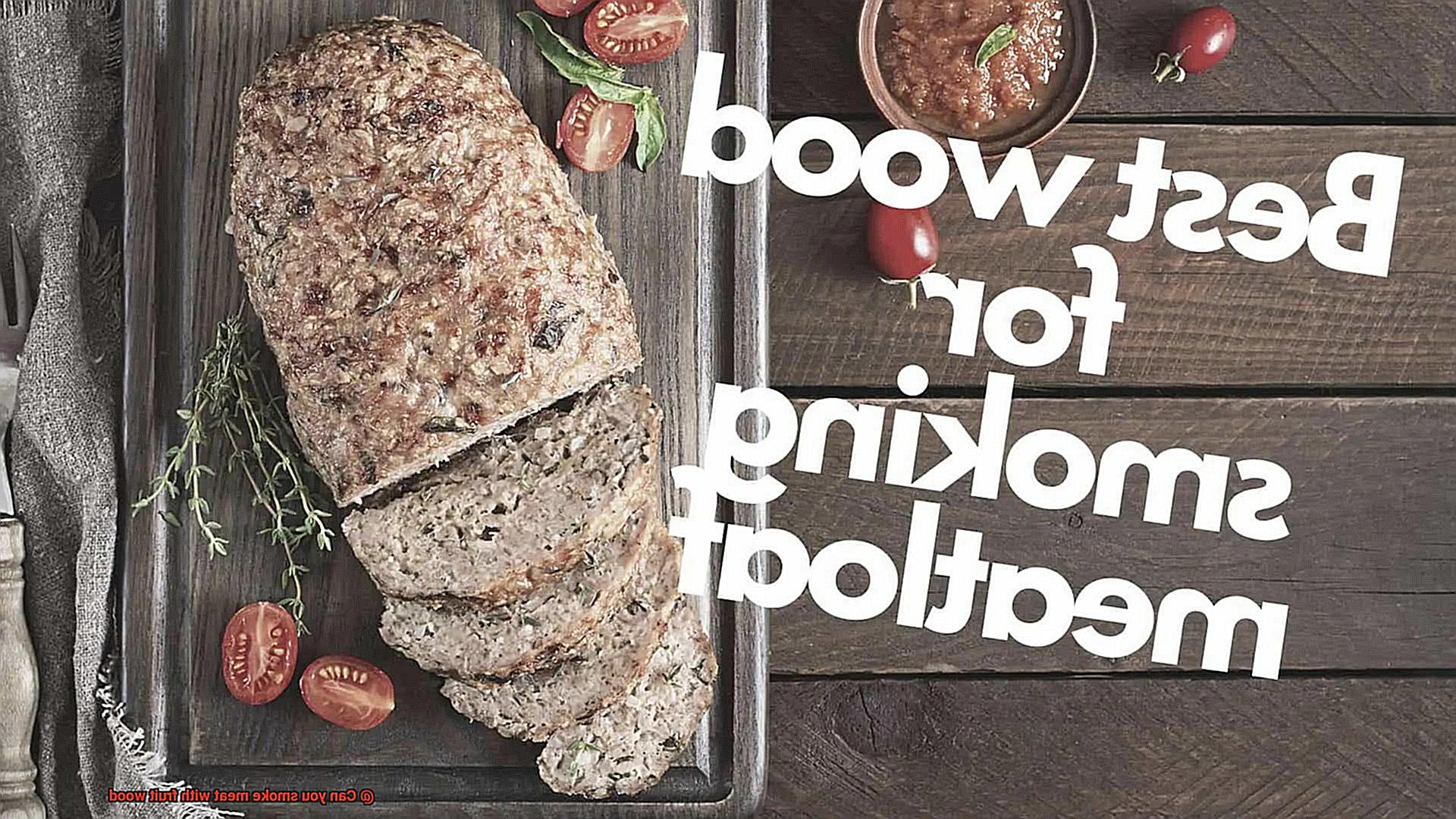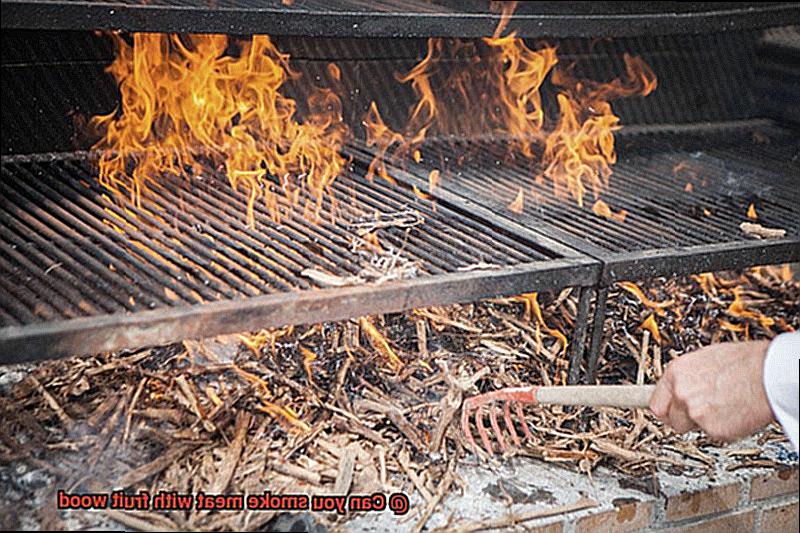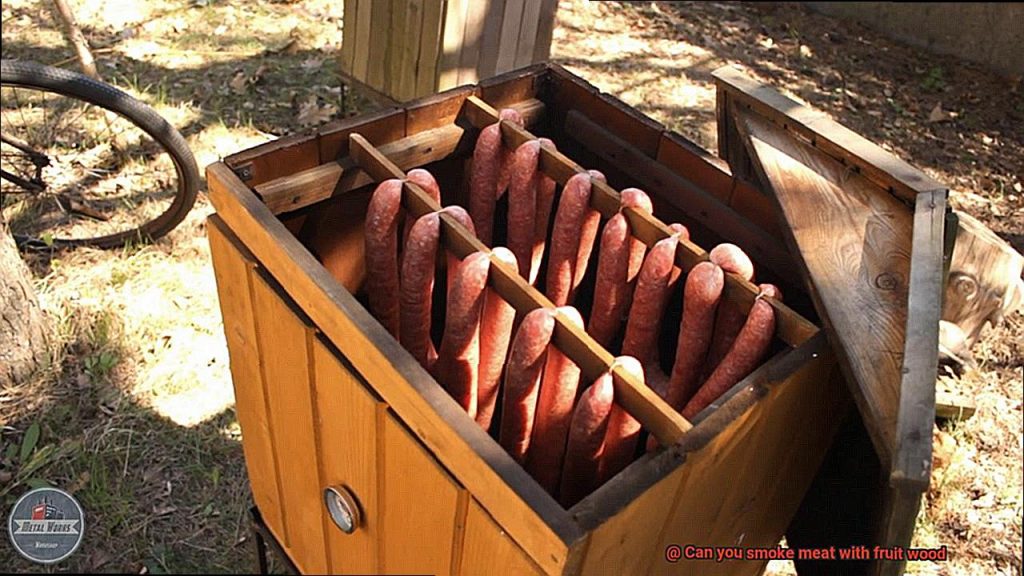Smoking meat is an age-old technique that has been used to preserve food and enhance its flavor. While most people swear by the traditional wood options like hickory, oak, and mesquite, there’s a new kid on the block – fruit wood. That’s right, you can smoke meat with apple, cherry, peach or any other fruit wood you fancy.
Fruit wood has become a popular choice for smoking meat in recent years due to its unique flavors and aromas. It brings a subtle sweetness to pork when smoked with apple wood while cherry wood adds a tart note to beef. The best part? Fruit wood is an affordable alternative to exotic woods and is widely available.
But can you really smoke meat with fruit wood? Absolutely. Fruit wood generates a milder smoke that works wonders for lighter meats like chicken, fish, and pork. Not only is it delicious, but it’s also healthier since it produces less creosote than traditional woods.
In this blog post, we’ll take a deeper dive into the world of fruit wood and explore its characteristics, benefits, and various options for smoking meat. Get ready for a mouth-watering adventure as we show you how to take your smoked meats to the next level using fruitwood.
Contents
Benefits of Smoking Meat with Fruit Wood
Smoking meat is an age-old tradition that has stood the test of time for its ability to add a unique and mouth-watering flavor to meats. While there are many types of wood that can be used for smoking, fruit woods such as apple, cherry, peach, and pear have gained popularity in recent years due to their sweet and subtle flavor profiles.
One of the biggest benefits of using fruit wood for smoking is the delicate balance it adds to the natural flavor of meat. Unlike other types of wood, fruit woods provide a sweet and mild flavor that complements the savory taste of meat, resulting in a perfectly balanced taste. Plus, the smoke from fruit woods gives meats a golden brown color that looks as appetizing as it tastes.
Another advantage of using fruit wood is its clean-burning properties. Fruit woods burn cleaner than other types of wood, producing less soot and ash. This means that there will be less mess to clean up after you are done cooking, making cleanup a breeze.
Fruit woods are also versatile and can be used for smoking a variety of meats. Each type of wood brings out unique flavors in different meats, allowing for endless possibilities in creating unique and delicious dishes. From poultry to pork, beef to fish, fruit woods offer something for everyone.
When smoking meat with fruit wood, it’s important to ensure that the wood is well-seasoned and dried before use. This ensures that it burns evenly and produces a consistent smoke that infuses meat with flavor.
Lastly, using fruit wood for smoking is an affordable option for those who want to experiment with new flavors without breaking the bank. Fruit woods are widely available and often less expensive than other smoking woods such as hickory or mesquite.
Different Types of Fruit Woods for Smoking Meat
Shake things up with a touch of fruit wood. Using apple, cherry, peach, plum, pear or apricot wood can add a unique sweetness and aroma to your smoked dishes that will leave your taste buds begging for more.
Apple wood is a versatile option that pairs well with pork, chicken, and fish. Its mild flavor profile offers a subtle sweetness that won’t overpower the meat. In contrast, cherry wood has a slightly sweet and fruity taste that complements beef and pork particularly well. Plus, it adds a beautiful reddish hue to the meat.
If you’re looking for a subtler fruit wood, peach wood is an excellent choice. It still adds a nice fruity flavor to smoked meats but has a more delicate taste than apple or cherry wood. It pairs well with pork and poultry, especially when combined with other woods like hickory or oak. Plum wood is similarly subtle in terms of its flavor profile, but its mild sweetness works wonders with poultry and game meats like duck and venison.

Pear wood is perfect for those who want a hint of sweetness in their meat without it being too overwhelming. It works well with pork and poultry and adds a mellow sweetness to the final product. Apricot wood is another option for smoking meat, although it can be difficult to find. Its slightly sweet and tangy flavor pairs well with pork and poultry, making it worth the effort to seek out.
When selecting a fruit wood for smoking meat, it’s essential to consider the type of meat being smoked and the desired flavor profile. Different fruit woods pair better with certain types of meat than others, so it’s worth experimenting with combinations until you find the perfect match. Remember to use quality wood that is free from pesticides and harmful chemicals to ensure that your dishes are not only delicious but also safe to consume.
How to Properly Season and Dry Fruit Wood Before Use
Smoking meat with fruit wood is an art form that requires patience and attention to detail. To achieve the best results, it’s important to properly season and dry fruit wood before use. This involves removing excess moisture from the wood to prevent it from producing too much smoke and creating a bitter taste in the meat.
Cutting and Storing Fruit Wood
The first step in seasoning fruit wood is to cut it into small pieces and remove any bark or debris. It’s best to cut the wood into smaller pieces, around 2-3 inches in diameter, for quicker and more efficient drying. The wood should then be stacked in a dry, well-ventilated area where it can receive plenty of airflow. It’s important to keep the wood off the ground and away from any moisture sources, such as rain or snow.

Allowing the Wood to Season
As the wood dries, it will begin to crack and split, which is normal and actually desirable as it allows more air flow and speeds up the drying process. The wood should be left to season for at least six months, although some types of fruit wood may require up to a year or more. During this time, it’s important to periodically check on the wood and make sure it’s not getting too dry or developing any mold.
Drying the Wood
Once the wood has been seasoned for at least six months, it’s time to start drying it. Drying the wood involves further removing moisture from the wood to ensure it’s ready for use in smoking meat. The best way to dry fruit wood is to place it in a kiln or smoker at a low temperature for several hours until it’s completely dry. This ensures that all excess moisture has been removed from the wood.
Choosing the Right Type of Fruit Wood
Different types of fruit wood will produce different flavors, so it’s important to choose the right type of wood for the meat being smoked. For example, applewood has a sweet and fruity flavor that pairs well with pork or chicken, while cherrywood has a mild flavor that is perfect for beef or lamb. Experimentation is key to finding the perfect combination of fruit wood and meat.
Using the Proper Amount of Fruit Wood
Using too much fruit wood can overpower the flavor of the meat, so it’s best to start with a small amount and add more as needed. The key is to find the right balance of fruit wood to achieve the desired flavor profile. It’s important to note that even properly seasoned and dried fruit wood will still produce smoke, so it’s best to use a moderate amount for the best results.
The Right Amount of Wood to Use When Smoking Meat
The key to success is to strike a fine balance between too much and too little wood. Too much wood can result in an overpowering smoke flavor that may not be desirable, while too little wood may not provide enough smoke flavor to the meat. The general rule of thumb is to use approximately 1-2 ounces of wood per hour of smoking time.
However, this is not a one-size-fits-all approach. Several other factors come into play when determining the right amount of wood to use. Firstly, the size of the meat matters. Smaller cuts of meat will require less wood, while larger cuts will need more. Secondly, the type of fruit wood used is crucial to achieving the perfect balance of flavor. Applewood, cherrywood, and peachwood are popular fruit woods that provide a mild and sweet smoke flavor that complements many types of meat. Stronger fruit woods such as hickory or mesquite may overwhelm the meat with a strong and smoky flavor if too much is used. So, choose wisely according to your personal preference.
Another factor to consider is the age and moisture content of the wood. Dried or seasoned wood will provide a consistent and even smoke, while green or wet wood may produce a bitter or unpleasant smoke flavor.

Now that we’ve covered the basics let’s get experimental. Try using different amounts and types of fruit wood until you find the right balance for your taste preferences. Remember, smoking meat with fruit wood requires patience and attention to detail, but it’s worth it for that perfectly smoked piece of meat.
In summary, here are some key takeaways for achieving the perfect balance of fruit wood flavor in your smoked meat:
- Use approximately 1-2 ounces of wood per hour of smoking time
- Consider the size of the meat being smoked
- Choose the right type of fruit wood according to your personal preference
- Use dried or seasoned wood for consistent smoke flavor
Tips for Getting the Best Flavor Out of Your Smoked Meats
Fruit woods like apple, cherry, and peach are some of the most popular choices among pitmasters due to their delicate and sweet flavors. However, not all fruit wood is created equal, and there are some tips to follow to get the best flavor out of your smoked meats when using fruit wood.
Choose the Right Type of Fruit Wood
Different types of fruit wood will impart different flavors to your meat. Apple wood is known for its sweet and fruity flavor, while cherry wood has a mild and slightly sweet taste. Peach wood has a more subtle flavor that pairs well with lighter meats like poultry and fish. Experimenting with different types of fruit wood will allow you to find the one that best complements the meat you are smoking.
Use Seasoned Wood
The key to getting the best flavor out of your fruit wood is using seasoned wood that has been dried out for at least six months. This will ensure that the wood burns cleanly and evenly, without producing too much smoke or creating off-flavors in your meat. Look for high-quality seasoned fruit wood from trusted suppliers.
Soak the Wood
Some pitmasters like to soak their fruit wood in water before using it to smoke meat. This can help reduce the amount of smoke produced by the wood and create a milder flavor in your meat. However, others argue that soaking can actually dilute the flavor of the wood and recommend using dry wood instead. It’s up to you to decide what works best for you, but if you do choose to soak your fruit wood, don’t soak it for too long – 30 minutes is enough.
Control Your Temperature
When smoking meat with fruit wood, maintaining a consistent temperature throughout the cooking process is crucial. Too much heat can cause the wood to burn too quickly and produce bitter flavors in your meat, while too little heat can result in undercooked or tough meat. Keep an eye on the temperature of your smoker and adjust it as needed.
Don’t Over-Smoke
While fruit woods are known for their mild and fruity flavors, it’s still possible to over-smoke your meat and create an overpowering flavor. Use a light hand when adding fruit wood to your smoker and monitor the smoke level throughout the cooking process. Thick, billowing smoke is a sign that you’re using too much wood, so back off on the wood or adjust your temperature accordingly.
Common Mistakes to Avoid When Smoking Meat with Fruit Wood
If you’re new to smoking meat with fruit wood, it’s important to avoid common mistakes that could ruin your dish and leave you feeling disappointed. Here are some tips to help you get the best results from your fruit wood smoking.
Firstly, don’t overlook the importance of properly seasoning and drying your fruit wood. If it’s too wet or green, it can produce too much smoke and give your meat an unpleasant taste. Take the time to prepare your wood properly to ensure a smooth smoking process.
Another mistake is using too much fruit wood. While it adds a unique and delicious flavor to your meat, too much of it can be overpowering and result in an overly sweet taste. Instead, try mixing it with other types of wood like hickory or oak for a more balanced flavor.
It’s also essential to give your meat enough time in the smoker to fully absorb the flavor from the fruit wood. Rushing this step could result in a lack of flavor or uneven cooking. Patience is key when it comes to smoking meat with fruit wood.
Additionally, regulating the temperature of your smoker is crucial for success. If the temperature is too high, it can cause your meat to burn or cook unevenly. Conversely, if the temperature is too low, your meat may not cook through properly. Monitoring the temperature closely and making adjustments as needed will help you achieve perfect results.
Lastly, don’t forget to experiment with different combinations of fruit wood and smoking techniques until you find what works best for you. With these tips in mind, you’ll be able to smoke succulent meats with perfectly balanced sweet and smoky flavors that will impress your guests every time.
Different Types of Meats Suitable for Smoking with Fruit Wood
Smoking meat with fruit wood is a culinary art that requires careful consideration of the type of meat, fruit wood, seasoning, and amount of wood used. Here are some subtopics to consider when smoking different types of meats with fruit wood:
Poultry
Chicken and turkey are two poultry meats that work well with fruit wood smoke. The sweetness of the fruit wood complements the natural flavors of the poultry, resulting in a mouthwatering combination. When smoking chicken, peach wood is an excellent choice as it adds a delicate and sweet flavor to the meat. Pecan wood is also a great option as it provides a nutty and slightly sweet flavor that pairs well with chicken. The key to smoking poultry is to ensure that it’s cooked thoroughly to avoid any health risks.
Pork
Pork is a versatile meat that pairs well with many different types of fruit wood. Whether you’re smoking a pork shoulder or ribs, the sweetness of the fruit wood can help cut through the richness of the meat and create a well-balanced flavor. When smoking pork, applewood is a popular choice as it adds a sweet and fruity flavor to the meat. Cherry wood is another great option as it provides a mild, sweet flavor that complements the natural sweetness of the pork. To achieve tender and juicy pork, ensure that you smoke it at low temperatures for an extended period.
Fish
Smoking fish with fruit wood can add a unique and delicious flavor to your dish. Some types of fish that work well with fruit wood smoke include salmon, trout, and tuna. Alderwood is an excellent choice when smoking fish as it provides a light and delicate smoke flavor that pairs well with fish’s mild taste. Cherry wood is another great option as it adds a mild sweetness to the fish without being too overpowering. To prevent overcooking the fish, smoke it for only 30 minutes to an hour.
Beef
While beef may not be the first type of meat that comes to mind when you think of smoking with fruit wood, it can still be a great option. Some cuts of beef, like brisket, can benefit from the sweet and fruity notes of fruit wood smoke. When smoking beef, hickory wood is a popular choice as it provides a strong and smoky flavor that complements the beef’s natural taste. Oak wood is another great option as it adds a milder smoky flavor that doesn’t overpower the beef. To get tender and juicy beef, smoke it at low temperatures for several hours.
Choosing the Right Fruit Wood:
The type of fruit wood you choose can impact the flavor profile of your smoked meat. For example, apple wood tends to have a sweeter and milder flavor, while cherry wood has a slightly more robust flavor profile. Experimenting with different types of fruit wood and meats can help you find the perfect combination for your taste preferences. Additionally, ensure that the fruit wood is properly seasoned and dried before use to produce consistent smoke.
What Temperature Should You Smoke Your Meats At?
Look no further than the temperature you should be smoking your meats at when using fruit wood. But beware, not all meats are created equal, and neither are the woods used for smoking.
For most meats, aim for a temperature range between 225-250°F. This range allows for slow cooking and absorption of the smoky flavor of fruit wood. However, poultry and fish require a higher cooking temperature of around 275-300°F to prevent drying out while ensuring it’s cooked through.
But there’s more to consider when it comes to fruit wood. Unlike other types of wood, like hickory or oak, fruit wood burns at a lower temperature. So, to achieve the desired results, you may need to adjust your cooking time and temperature slightly. To prevent your fruit wood from burning too quickly, soak your chips or chunks in water for 30 minutes before adding them to the smoker. This will help produce more smoke and enhance the flavor of your meat.
To summarize, here are some key points to keep in mind when smoking with fruit wood:
- For most meats: 225-250°F
- For poultry and fish: 275-300°F
- Fruit wood burns at a lower temperature than other types of wood
- Adjust cooking time and temperature accordingly
- Soak fruit wood chips or chunks in water for 30 minutes before use
VXw4LR1XlGM” >
Conclusion
In conclusion, smoking meat with fruit wood is not only possible but also highly recommended.
The sweet and fruity flavors that the wood imparts on the meat are unmatched by any other type of wood. Whether you’re smoking chicken, pork, or beef, using fruit wood will give your meat a unique and delicious taste that will leave your guests wanting more.
So next time you fire up your smoker, don’t be afraid to experiment with different types of fruit wood and see what flavor combinations you can come up with.






